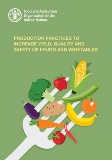FAO provides new guidelines to maximize crop yields and improve food safety
Good agricultural practices (GAP) boost plant health and contribute to ‘One Health’

FAO has published targeted guidelines for farmers on best practices to increase crop yields that ensure foods produced are of high quality and safe. Production practices to increase yield, quality and safety of fruits and vegetables outlines practical measures to combat plant diseases that reduce reliance on pesticides, including antimicrobials.
The aim of the publication is to facilitate the production of horticultural products which are both safe and of high quality, therefore certain to gain market access. The booklet provides suggestions on how to avoid and prevent plant diseases and how to manage them when they do arise.
Although some bacteria and fungi cause crop diseases and hence threaten yields, there are others that benefit crop performance. For the control of the bacteria and fungi that cause crop diseases, antibiotics and fungicides, respectively, can potentially be used. However, the risk of using antibiotics and fungicides is that beneficial organisms are killed and that risks to antimicrobial resistance (AMR) are increased in the environment, across agrifood systems and in the public health domain.
For the crop sector there are practical agronomic measures (appropriate sanitation and crop rotation) that can be deployed for the management of diseases caused by bacteria and hence there is no need for antibiotic use. For crop diseases caused by fungi, fungicides are required. Although fungicides are less strongly linked to AMR, with the exception of e.g. triazoles that cause human diseases due to infection by Aspergillus spp., many fungicides are considered necessary for sustainable crop production.
Fungicides and pesticides in general must only be used when no other control option is available and in a judicious manner, e.g. correct product related to appropriate diagnosis of causal agent of crop disease, correct dose, correct application method and to respect recommended harvest intervals.
The booklet recommends six agricultural practices:
- preventing plant pests and diseases through integrated pest management including agronomic practices and biological control options;
- using water that is fit for purpose;
- treating soil to reduce microbial contaminants;
- maintaining clean farm equipment and containers;
- keeping animals away from fields and packing facilities; and
- practising good hygiene, sanitation and biosecurity.
These practices focus on GAP to minimize crop disease and also promote sanitation standards (for foodborne human diseases), such as through appropriate composting, soil and water treatments. The benefit to the farmer is reduced production costs, and to the consumer, food that is safe.
FAO promotes the One Health approach to sustainably balance and optimize the health of people, animals and ecosystems. It recognizes the links among the health of people, domestic and wild animals, plants and the wider environment.

